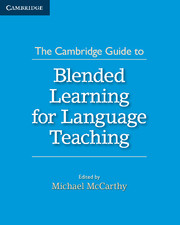Chapter 8 - Reconceptualising Materials for the Blended Language Learning Environment
Published online by Cambridge University Press: 22 September 2021
Summary
INTRODUCTION
The concept of language learning materials has been difficult to define ever since technology was added to the repertoire of media for language learning. This is partly because, historically, language teaching was rooted in print-based learning materials. The affordances (capabilities) of technology (and in particular, from the mid-2000s, Web 2.0 tools) made for shifting notions of ‘authorship’ together with a transition to materials in different media, with their variations in audio/audio-visual input and degrees of transience. These changes have broadened the scope of what were formerly understood as materials, but at the same time, have made for some ambiguity in the use of the term in the literature. For some, materials are still products created using technological applications (the word processor, podcasting software, and so on) or sourced from the web (e.g., YouTube videos). For others, technology has transformed materials from being products like this to being processes – of socialising, networking and collaborating (via tools such as social networking sites, wikis, etc.). Given these disparities, it would now seem time to reconcile these concepts of materials as regards technology and to look at how they are realised within the blended language learning (BLL) environments which increasingly characterise our educational landscape. In this endeavour, this chapter looks firstly at how the concept of materials has had to develop in line with the affordances of technology. It then consults frameworks for blended learning (BL) in the literature, focusing on the place of language materials within these, in order to evolve a conceptual model for materials in BLL contexts. In the second part of the chapter, samples from the author's practice and a cross-section of the contemporary literature are used to show how the model can be put into practice. The chapter closes by using the devised model as a measure to critically evaluate current parameters for BLL materials design.
REDEFINING MATERIALS FOR THE TECHNOLOGICAL/DIGITAL ENVIRONMENT
A logical starting point for this chapter is to explore definitions of the focus of the chapter, language learning material. A classic practical definition provided by Tomlinson is ‘anything used by teachers or learners to facilitate the learning of a language’ (2011: 2). Tomlinson goes on to list examples such as ‘videos, DVDs, emails, YouTube, dictionaries, grammar books, readers, workbooks or photocopied exercises […] newspapers, food packages, photographs, live talks by invited native speakers, instructions given by a teacher, tasks written on cards or discussions between learners’ (Ibid.: 2).
Information
- Type
- Chapter
- Information
- The Cambridge Guide to Blended Learning for Language Teaching , pp. 123 - 138Publisher: Cambridge University PressPrint publication year: 2015
Accessibility standard: Unknown
Why this information is here
This section outlines the accessibility features of this content - including support for screen readers, full keyboard navigation and high-contrast display options. This may not be relevant for you.Accessibility Information
- 1
- Cited by
